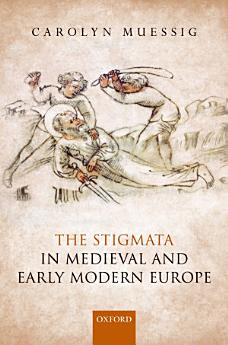The Stigmata in Medieval and Early Modern Europe
Carolyn Muessig
Feb 2020 · Oxford University Press
5.0star
1 reviewreport
Ebook
264
Pages
family_home
Eligible
info
reportRatings and reviews aren’t verified Learn More
About this ebook
Francis of Assisi's reported reception of the stigmata on Mount La Verna in 1224 is almost universally considered to be the first documented account of an individual miraculously and physically receiving the five wounds of Christ. The early thirteenth-century appearance of this miracle, however, is not as unexpected as it first seems. Interpretations of Galatians 6:17—I bear the marks of the Lord Jesus Christ in my body—had been circulating since the early Middle Ages in biblical commentaries. These works perceived those with the stigmata as metaphorical representations of martyrs bearing the marks of persecution in order to spread the teaching of Christ in the face of resistance. By the seventh century, the meaning of Galatians 6:17 had been appropriated by bishops and priests as a sign or mark of Christ that they received invisibly at their ordination. Priests and bishops came to be compared to soldiers of Christ, who bore the brand (stigmata) of God on their bodies, just like Roman soldiers who were branded with the name of their emperor. By the early twelfth century, crusaders were said to bear the actual marks of the passion in death and even sometimes as they entered into battle. The Stigmata in Late Medieval and Early Modern Europe traces the birth and evolution of religious stigmata and particularly of stigmatic theology, as understood through the ensemble of theological discussions and devotional practices. Carolyn Muessig assesses the role stigmatics played in medieval and early modern religious culture, and the way their contemporaries reacted to them. The period studied covers the dominant discourse of stigmatic theology: that is, from Peter Damian's eleventh-century theological writings to 1630 when the papacy officially recognised the authenticity of Catherine of Siena's stigmata.
Ratings and reviews
5.0
1 review
About the author
Carolyn Muessig is Professor of Medieval Religion and Co-Director at the Centre for Medieval Studies at the University of Bristol. She is a medievalist, specializing on the devotional practices and beliefs of late medieval Europe. Her interest in this area began during her studies for a BA in History from the State University of New York at Buffalo. Since 2001 she has been series co-editor (with George Ferzoco) of Routledge Studies in Medieval Religion and Culture. Her publications include A Companion to Catherine of Siena (co-edited with George Ferzoco and Beverly Mayne Kienzle; 2011), Envisaging Heaven in the Middle Age (co-edited with Ad Putter; 2007), and The Faces of Women in the Sermons of Jacques de Vitry (1999).
Rate this ebook
Tell us what you think.
Reading information
Smartphones and tablets
Install the Google Play Books app for Android and iPad/iPhone. It syncs automatically with your account and allows you to read online or offline wherever you are.
Laptops and computers
You can listen to audiobooks purchased on Google Play using your computer's web browser.
eReaders and other devices
To read on e-ink devices like Kobo eReaders, you'll need to download a file and transfer it to your device. Follow the detailed Help Center instructions to transfer the files to supported eReaders.






